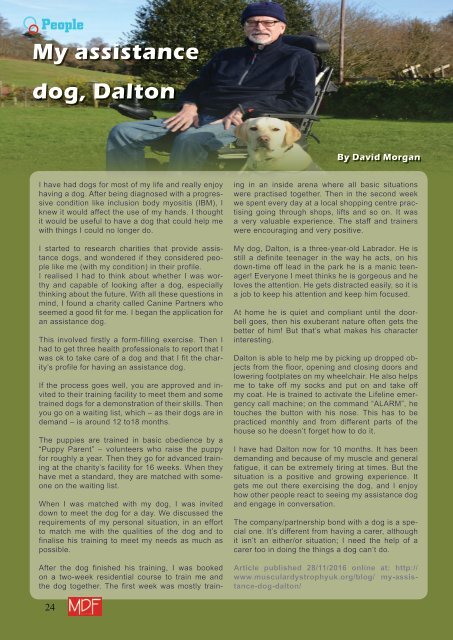MDF Magazine Issue 53 August 2017
You also want an ePaper? Increase the reach of your titles
YUMPU automatically turns print PDFs into web optimized ePapers that Google loves.
People<br />
My assistance<br />
dog, Dalton<br />
By David Morgan<br />
I have had dogs for most of my life and really enjoy<br />
having a dog. After being diagnosed with a progressive<br />
condition like inclusion body myositis (IBM), I<br />
knew it would affect the use of my hands. I thought<br />
it would be useful to have a dog that could help me<br />
with things I could no longer do.<br />
I started to research charities that provide assistance<br />
dogs, and wondered if they considered people<br />
like me (with my condition) in their profile.<br />
I realised I had to think about whether I was worthy<br />
and capable of looking after a dog, especially<br />
thinking about the future. With all these questions in<br />
mind, I found a charity called Canine Partners who<br />
seemed a good fit for me. I began the application for<br />
an assistance dog.<br />
This involved firstly a form-filling exercise. Then I<br />
had to get three health professionals to report that I<br />
was ok to take care of a dog and that I fit the charity’s<br />
profile for having an assistance dog.<br />
If the process goes well, you are approved and invited<br />
to their training facility to meet them and some<br />
trained dogs for a demonstration of their skills. Then<br />
you go on a waiting list, which – as their dogs are in<br />
demand – is around 12 to18 months.<br />
The puppies are trained in basic obedience by a<br />
“Puppy Parent” – volunteers who raise the puppy<br />
for roughly a year. Then they go for advanced training<br />
at the charity’s facility for 16 weeks. When they<br />
have met a standard, they are matched with someone<br />
on the waiting list.<br />
When I was matched with my dog, I was invited<br />
down to meet the dog for a day. We discussed the<br />
requirements of my personal situation, in an effort<br />
to match me with the qualities of the dog and to<br />
finalise his training to meet my needs as much as<br />
possible.<br />
After the dog finished his training, I was booked<br />
on a two-week residential course to train me and<br />
the dog together. The first week was mostly training<br />
in an inside arena where all basic situations<br />
were practised together. Then in the second week<br />
we spent every day at a local shopping centre practising<br />
going through shops, lifts and so on. It was<br />
a very valuable experience. The staff and trainers<br />
were encouraging and very positive.<br />
My dog, Dalton, is a three-year-old Labrador. He is<br />
still a definite teenager in the way he acts, on his<br />
down-time off lead in the park he is a manic teenager!<br />
Everyone I meet thinks he is gorgeous and he<br />
loves the attention. He gets distracted easily, so it is<br />
a job to keep his attention and keep him focused.<br />
At home he is quiet and compliant until the doorbell<br />
goes, then his exuberant nature often gets the<br />
better of him! But that’s what makes his character<br />
interesting.<br />
Dalton is able to help me by picking up dropped objects<br />
from the floor, opening and closing doors and<br />
lowering footplates on my wheelchair. He also helps<br />
me to take off my socks and put on and take off<br />
my coat. He is trained to activate the Lifeline emergency<br />
call machine; on the command “ALARM”, he<br />
touches the button with his nose. This has to be<br />
practiced monthly and from different parts of the<br />
house so he doesn’t forget how to do it.<br />
I have had Dalton now for 10 months. It has been<br />
demanding and because of my muscle and general<br />
fatigue, it can be extremely tiring at times. But the<br />
situation is a positive and growing experience. It<br />
gets me out there exercising the dog, and I enjoy<br />
how other people react to seeing my assistance dog<br />
and engage in conversation.<br />
The company/partnership bond with a dog is a special<br />
one. It’s different from having a carer, although<br />
it isn’t an either/or situation; I need the help of a<br />
carer too in doing the things a dog can’t do.<br />
Article published 28/11/2016 online at: http://<br />
www.musculardystrophyuk.org/blog/ my-assistance-dog-dalton/<br />
24


















